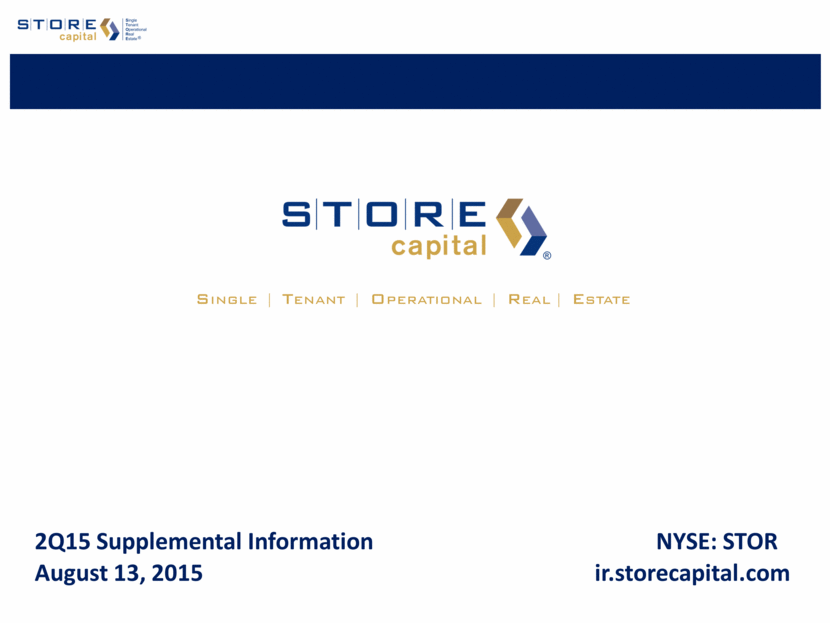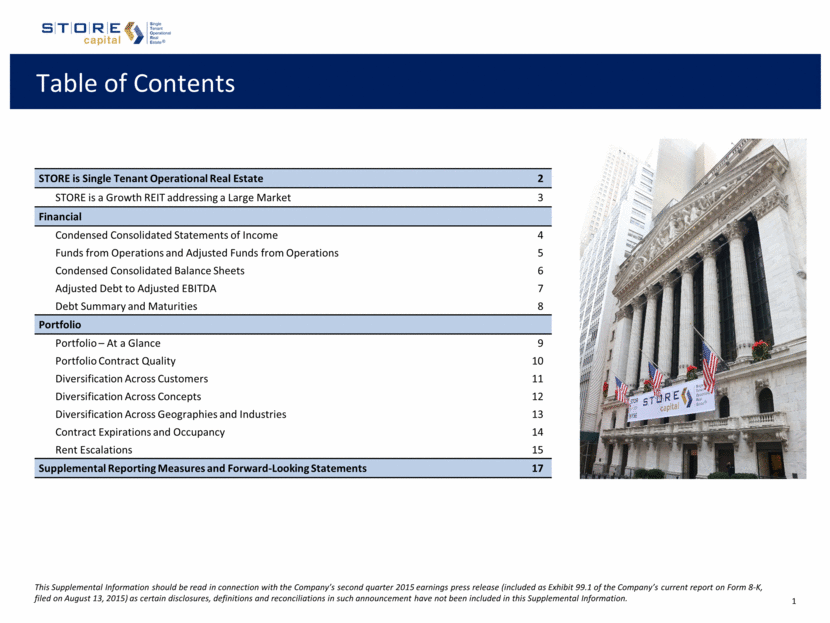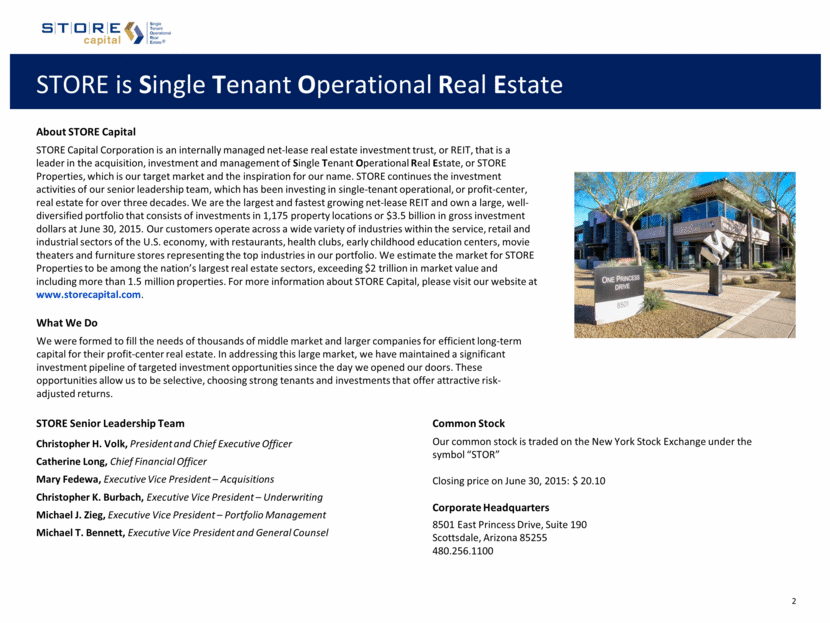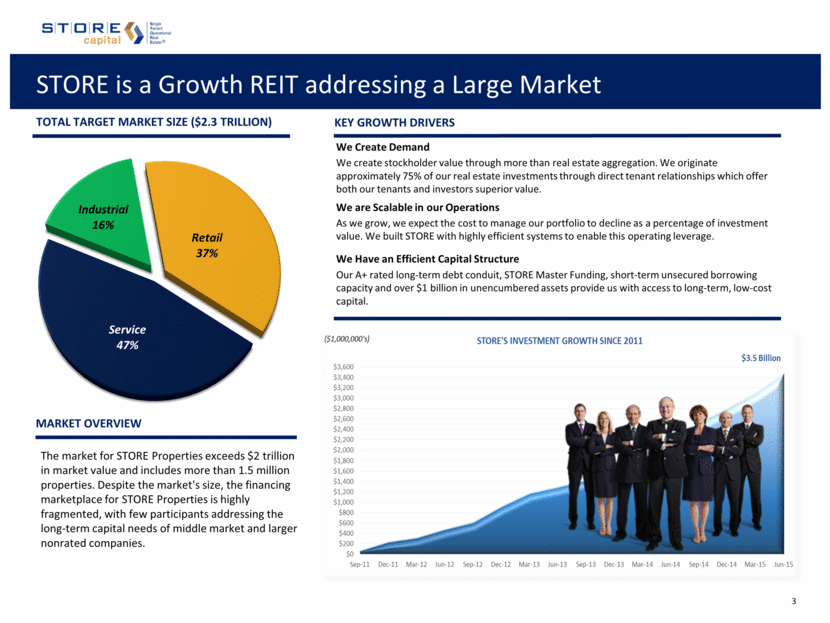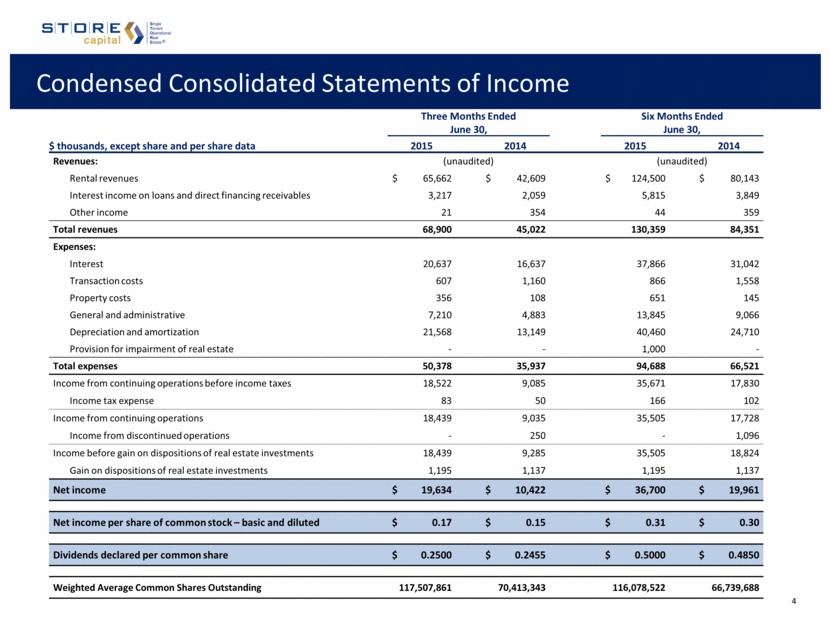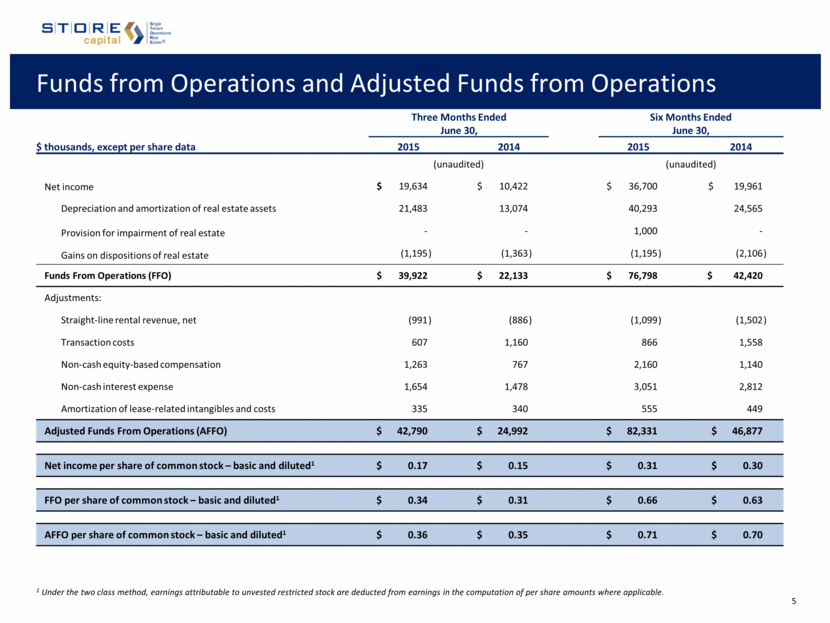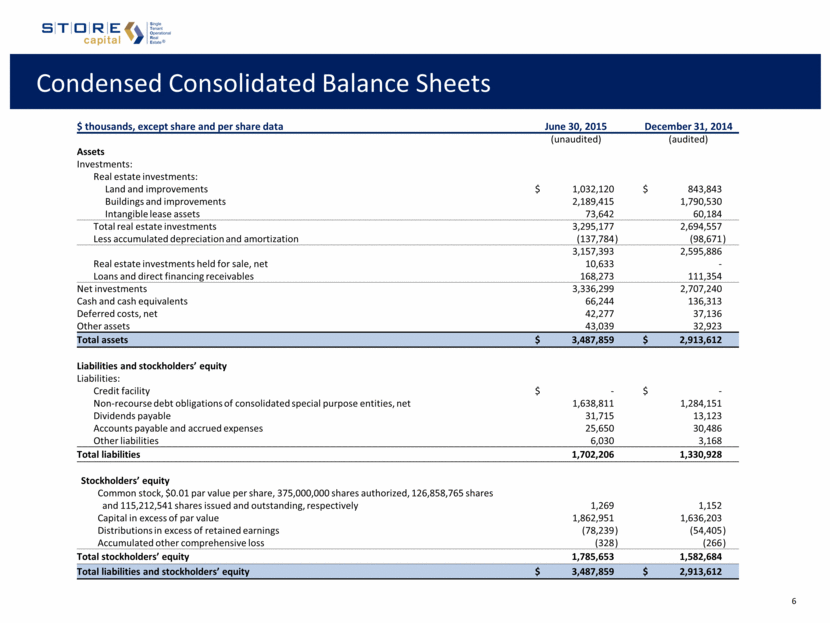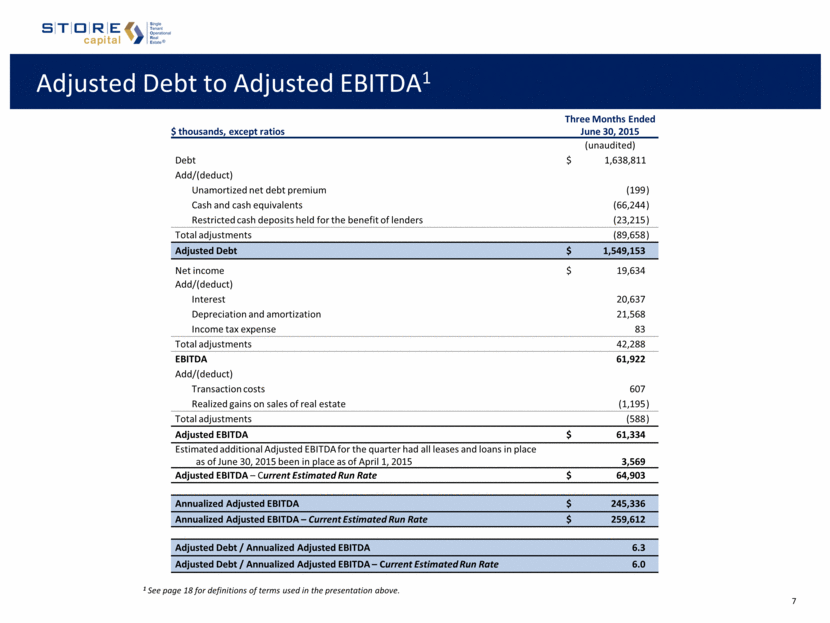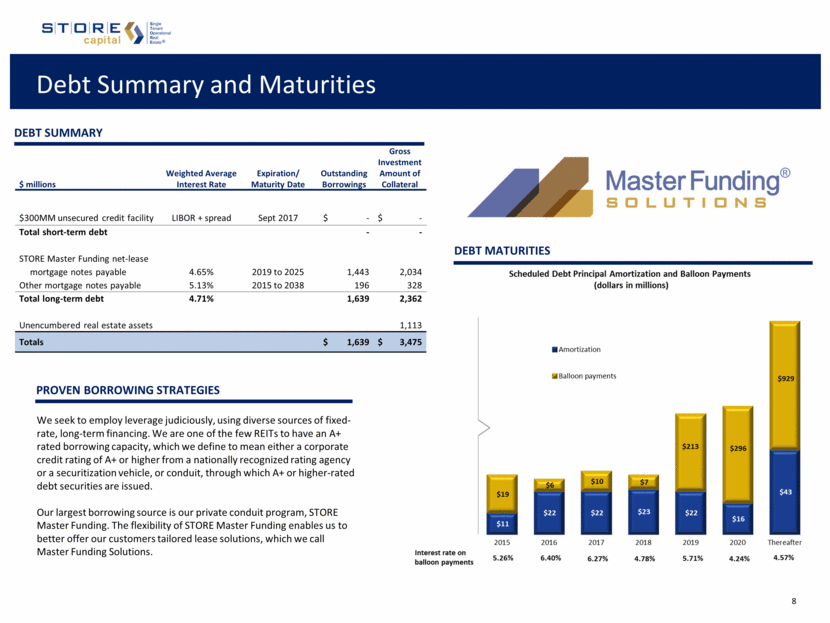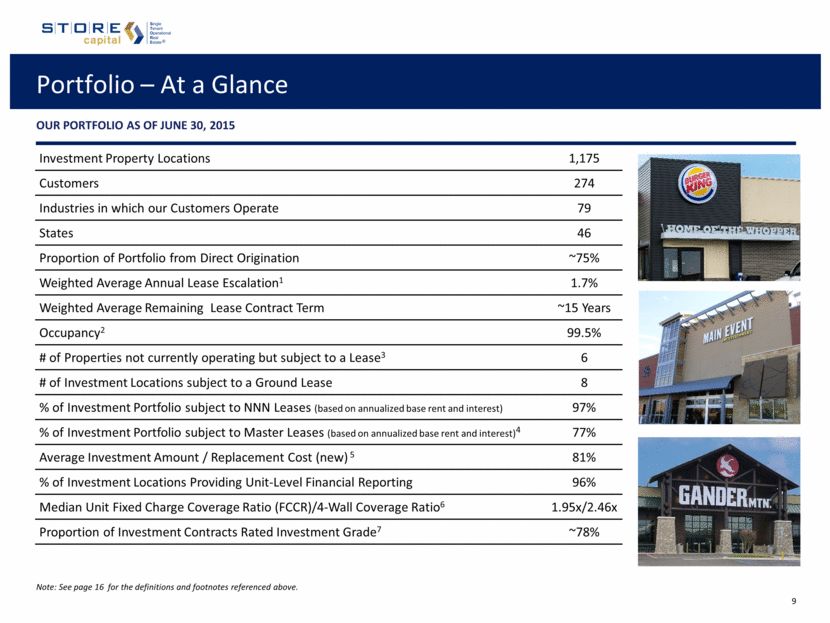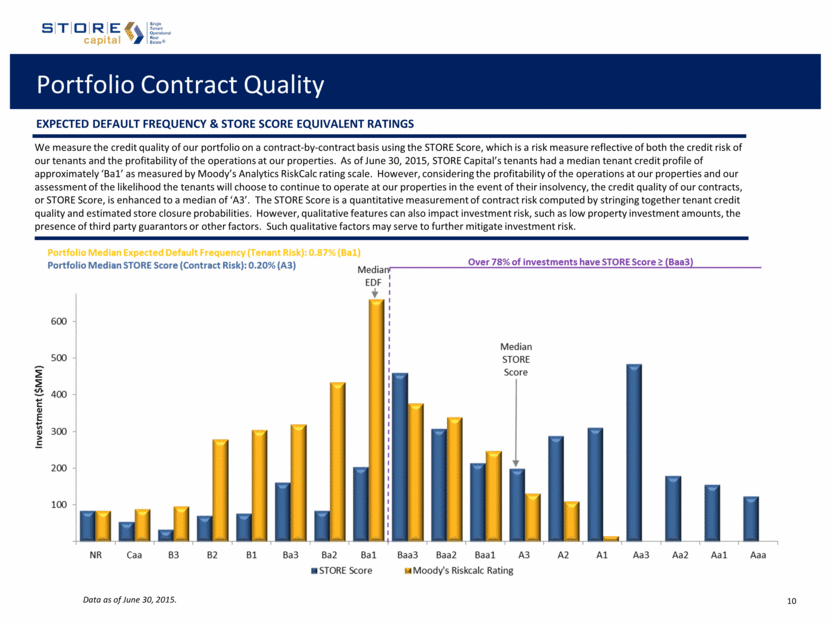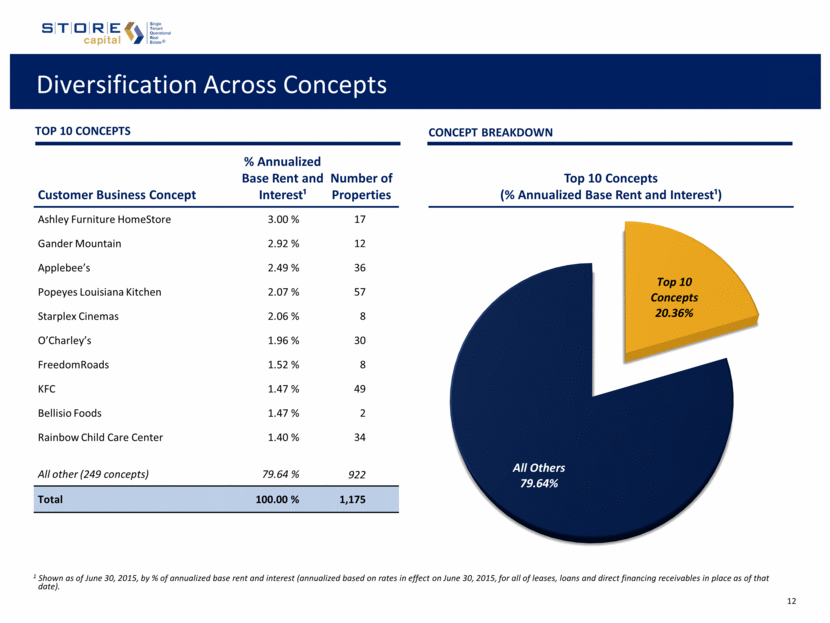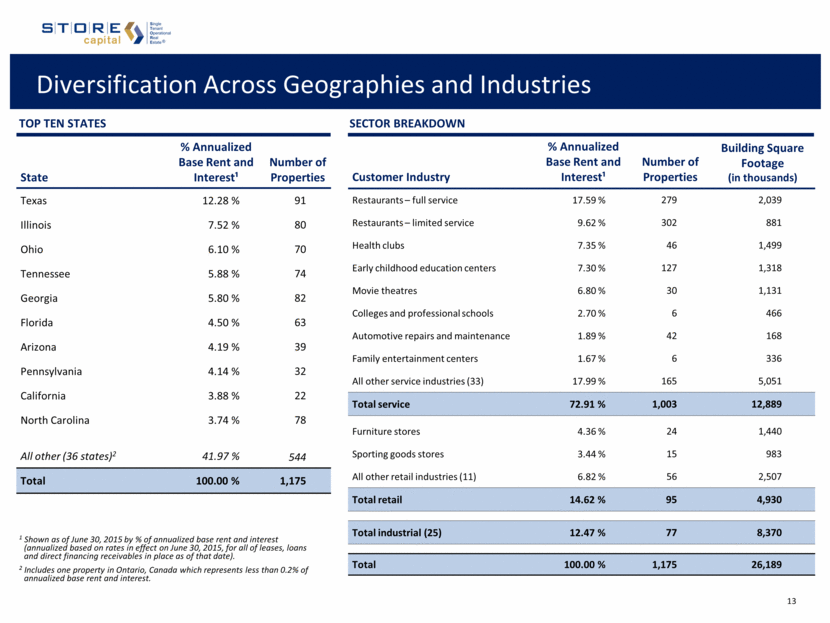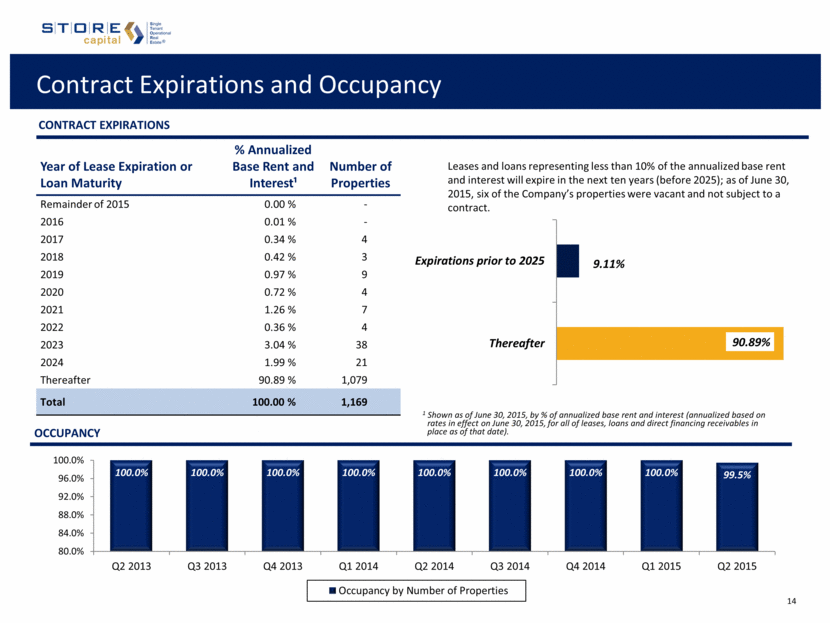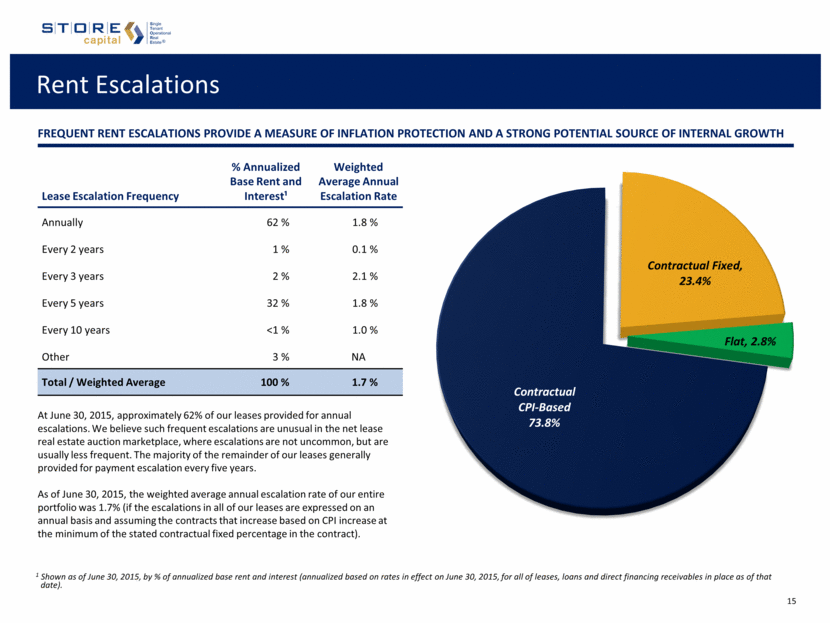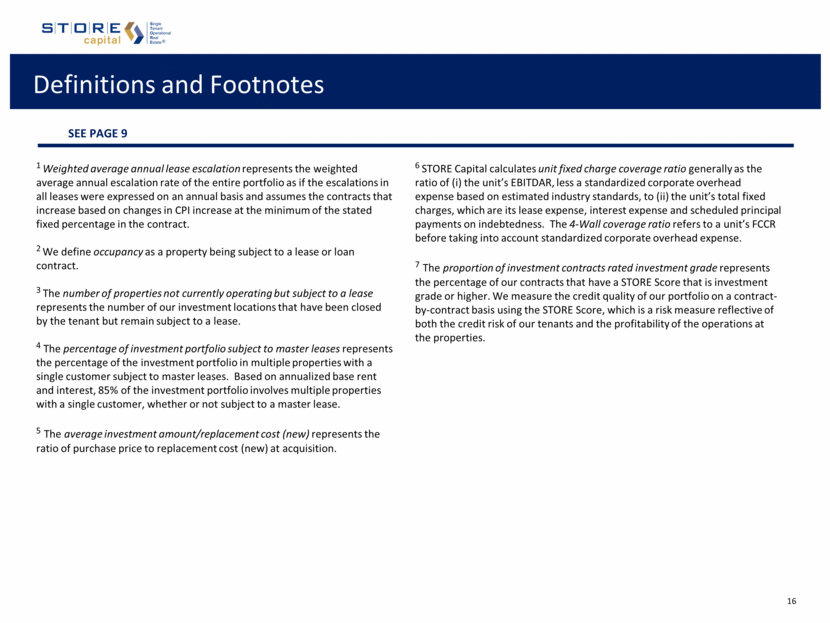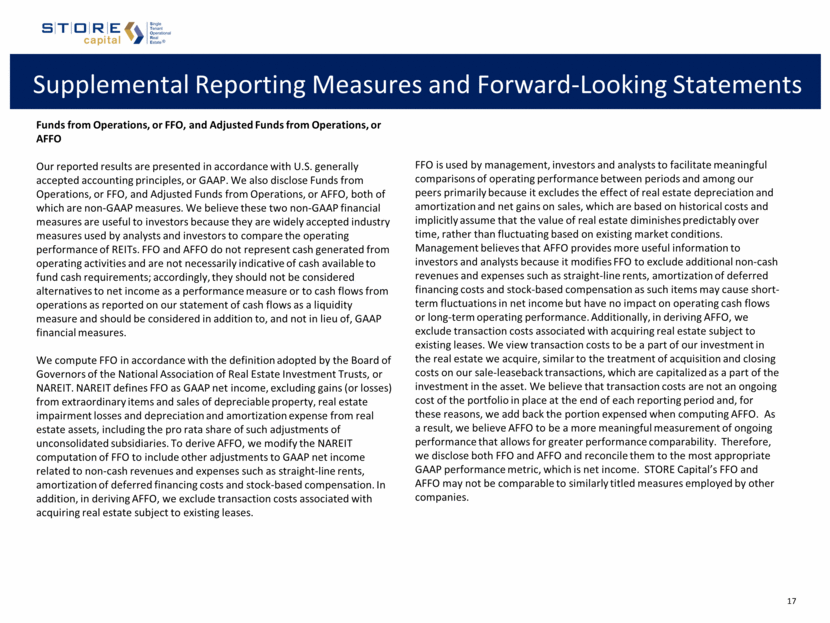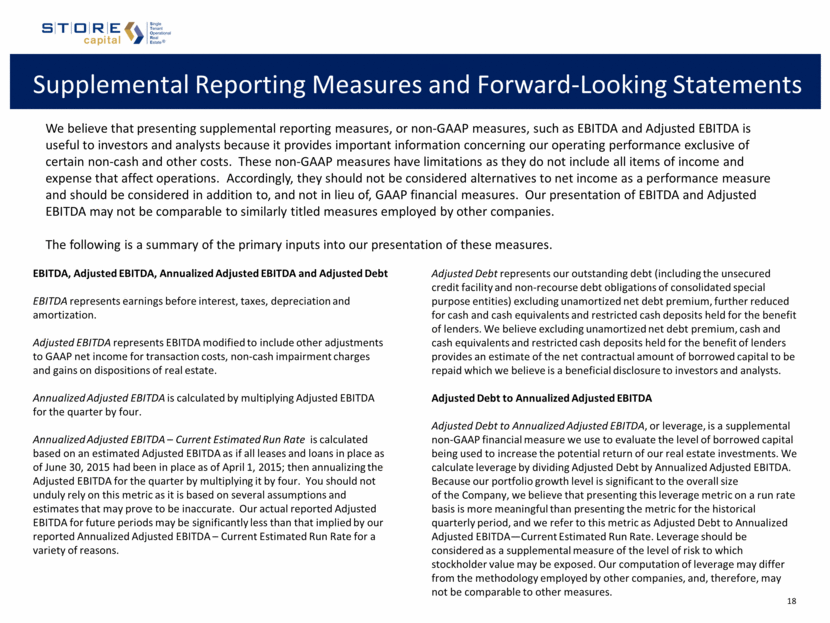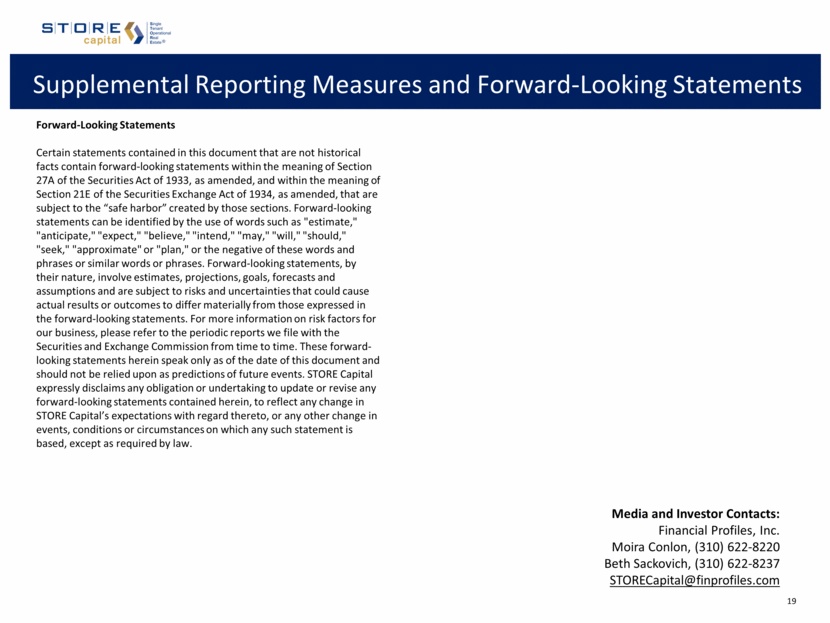Attached files
| file | filename |
|---|---|
| EX-99.1 - EX-99.1 - STORE CAPITAL Corp | a15-17538_1ex99d1.htm |
| 8-K - 8-K - STORE CAPITAL Corp | a15-17538_18k.htm |
Exhibit 99.2
|
|
2Q15 Supplemental Information NYSE: STOR August 13, 2015 ir.storecapital.com SINGLE TENANT OPERATIONAL REAL ESTATE |
|
|
Table of Contents This Supplemental Information should be read in connection with the Company’s second quarter 2015 earnings press release (included as Exhibit 99.1 of the Company’s current report on Form 8-K, filed on August 13, 2015) as certain disclosures, definitions and reconciliations in such announcement have not been included in this Supplemental Information. STORE is Single Tenant Operational Real Estate 2 STORE is a Growth REIT addressing a Large Market 3 Financial Condensed Consolidated Statements of Income 4 Funds from Operations and Adjusted Funds from Operations 5 Condensed Consolidated Balance Sheets 6 Adjusted Debt to Adjusted EBITDA 7 Debt Summary and Maturities 8 Portfolio Portfolio – At a Glance 9 Portfolio Contract Quality 10 Diversification Across Customers 11 Diversification Across Concepts 12 Diversification Across Geographies and Industries 13 Contract Expirations and Occupancy 14 Rent Escalations 15 Supplemental Reporting Measures and Forward-Looking Statements 17 |
|
|
STORE is Single Tenant Operational Real Estate About STORE Capital STORE Capital Corporation is an internally managed net-lease real estate investment trust, or REIT, that is a leader in the acquisition, investment and management of Single Tenant Operational Real Estate, or STORE Properties, which is our target market and the inspiration for our name. STORE continues the investment activities of our senior leadership team, which has been investing in single-tenant operational, or profit-center, real estate for over three decades. We are the largest and fastest growing net-lease REIT and own a large, well-diversified portfolio that consists of investments in 1,175 property locations or $3.5 billion in gross investment dollars at June 30, 2015. Our customers operate across a wide variety of industries within the service, retail and industrial sectors of the U.S. economy, with restaurants, health clubs, early childhood education centers, movie theaters and furniture stores representing the top industries in our portfolio. We estimate the market for STORE Properties to be among the nation’s largest real estate sectors, exceeding $2 trillion in market value and including more than 1.5 million properties. For more information about STORE Capital, please visit our website at www.storecapital.com. Common Stock Our common stock is traded on the New York Stock Exchange under the symbol “STOR” Closing price on June 30, 2015: $ 20.10 Corporate Headquarters 8501 East Princess Drive, Suite 190 Scottsdale, Arizona 85255 480.256.1100 STORE Senior Leadership Team Christopher H. Volk, President and Chief Executive Officer Catherine Long, Chief Financial Officer Mary Fedewa, Executive Vice President – Acquisitions Christopher K. Burbach, Executive Vice President – Underwriting Michael J. Zieg, Executive Vice President – Portfolio Management Michael T. Bennett, Executive Vice President and General Counsel What We Do We were formed to fill the needs of thousands of middle market and larger companies for efficient long-term capital for their profit-center real estate. In addressing this large market, we have maintained a significant investment pipeline of targeted investment opportunities since the day we opened our doors. These opportunities allow us to be selective, choosing strong tenants and investments that offer attractive risk-adjusted returns. |
|
|
STORE is a Growth REIT addressing a Large Market The market for STORE Properties exceeds $2 trillion in market value and includes more than 1.5 million properties. Despite the market's size, the financing marketplace for STORE Properties is highly fragmented, with few participants addressing the long-term capital needs of middle market and larger nonrated companies. TOTAL TARGET MARKET SIZE ($2.3 TRILLION) KEY GROWTH DRIVERS We Create Demand We create stockholder value through more than real estate aggregation. We originate approximately 75% of our real estate investments through direct tenant relationships which offer both our tenants and investors superior value. We are Scalable in our Operations As we grow, we expect the cost to manage our portfolio to decline as a percentage of investment value. We built STORE with highly efficient systems to enable this operating leverage. We Have an Efficient Capital Structure Our A+ rated long-term debt conduit, STORE Master Funding, short-term unsecured borrowing capacity and over $1 billion in unencumbered assets provide us with access to long-term, low-cost capital. MARKET OVERVIEW Retail 37 % Service 47 % Industrial 16 % |
|
|
Condensed Consolidated Statements of Income Three Months Ended June 30, Six Months Ended June 30, $ thousands, except share and per share data 2015 2014 2015 2014 Revenues: (unaudited) (unaudited) Rental revenues $ 65,662 $ 42,609 $ 124,500 $ 80,143 Interest income on loans and direct financing receivables 3,217 2,059 5,815 3,849 Other income 21 354 44 359 Total revenues 68,900 45,022 130,359 84,351 Expenses: Interest 20,637 16,637 37,866 31,042 Transaction costs 607 1,160 866 1,558 Property costs 356 108 651 145 General and administrative 7,210 4,883 13,845 9,066 Depreciation and amortization 21,568 13,149 40,460 24,710 Provision for impairment of real estate - - 1,000 - Total expenses 50,378 35,937 94,688 66,521 Income from continuing operations before income taxes 18,522 9,085 35,671 17,830 Income tax expense 83 50 166 102 Income from continuing operations 18,439 9,035 35,505 17,728 Income from discontinued operations - 250 - 1,096 Income before gain on dispositions of real estate investments 18,439 9,285 35,505 18,824 Gain on dispositions of real estate investments 1,195 1,137 1,195 1,137 Net income $ 19,634 $ 10,422 $ 36,700 $ 19,961 Net income per share of common stock – basic and diluted $ 0.17 $ 0.15 $ 0.31 $ 0.30 Dividends declared per common share $ 0.2500 $ 0.2455 $ 0.5000 $ 0.4850 Weighted Average Common Shares Outstanding 117,507,861 70,413,343 116,078,522 66,739,688 |
|
|
Funds from Operations and Adjusted Funds from Operations Three Months Ended June 30, Six Months Ended June 30, $ thousands, except per share data 2015 2014 2015 2014 Net income (unaudited) (unaudited) $ 19,634 $ 10,422 $ 36,700 $ 19,961 Depreciation and amortization of real estate assets 21,483 13,074 40,293 24,565 Provision for impairment of real estate - - 1,000 - Gains on dispositions of real estate (1,195) (1,363) (1,195) (2,106) Funds From Operations (FFO) $ 39,922 $ 22,133 $ 76,798 $ 42,420 Adjustments: Straight-line rental revenue, net (991) (886) (1,099) (1,502) Transaction costs 607 1,160 866 1,558 Non-cash equity-based compensation 1,263 767 2,160 1,140 Non-cash interest expense 1,654 1,478 3,051 2,812 Amortization of lease-related intangibles and costs 335 340 555 449 Adjusted Funds From Operations (AFFO) $ 42,790 $ 24,992 $ 82,331 $ 46,877 Net income per share of common stock – basic and diluted1 $ 0.17 $ 0.15 $ 0.31 $ 0.30 FFO per share of common stock – basic and diluted1 $ 0.34 $ 0.31 $ 0.66 $ 0.63 AFFO per share of common stock – basic and diluted1 $ 0.36 $ 0.35 $ 0.71 $ 0.70 1 Under the two class method, earnings attributable to unvested restricted stock are deducted from earnings in the computation of per share amounts where applicable. |
|
|
Condensed Consolidated Balance Sheets $ thousands, except share and per share data June 30, 2015 December 31, 2014 (unaudited) (audited) Assets Investments: Real estate investments: Land and improvements $ 1,032,120 $ 843,843 Buildings and improvements 2,189,415 1,790,530 Intangible lease assets 73,642 60,184 Total real estate investments 3,295,177 2,694,557 Less accumulated depreciation and amortization (137,784) (98,671) 3,157,393 2,595,886 Real estate investments held for sale, net 10,633 - Loans and direct financing receivables 168,273 111,354 Net investments 3,336,299 2,707,240 Cash and cash equivalents 66,244 136,313 Deferred costs, net 42,277 37,136 Other assets 43,039 32,923 Total assets $ 3,487,859 $ 2,913,612 Liabilities and stockholders’ equity Liabilities: Credit facility $ - $ - Non-recourse debt obligations of consolidated special purpose entities, net 1,638,811 1,284,151 Dividends payable 31,715 13,123 Accounts payable and accrued expenses 25,650 30,486 Other liabilities 6,030 3,168 Total liabilities 1,702,206 1,330,928 Stockholders’ equity Common stock, $0.01 par value per share, 375,000,000 shares authorized, 126,858,765 shares and 115,212,541 shares issued and outstanding, respectively 1,269 1,152 Capital in excess of par value 1,862,951 1,636,203 Distributions in excess of retained earnings (78,239) (54,405) Accumulated other comprehensive loss (328) (266) Total stockholders’ equity 1,785,653 1,582,684 Total liabilities and stockholders’ equity $ 3,487,859 $ 2,913,612 |
|
|
Adjusted Debt to Adjusted EBITDA1 $ thousands, except ratios Three Months Ended June 30, 2015 (unaudited) Debt $ 1,638,811 Add/(deduct) Unamortized net debt premium (199) Cash and cash equivalents (66,244) Restricted cash deposits held for the benefit of lenders (23,215) Total adjustments (89,658) Adjusted Debt $ 1,549,153 Net income $ 19,634 Add/(deduct) Interest 20,637 Depreciation and amortization 21,568 Income tax expense 83 Total adjustments 42,288 EBITDA 61,922 Add/(deduct) Transaction costs 607 Realized gains on sales of real estate (1,195) Total adjustments (588) Adjusted EBITDA $ 61,334 Estimated additional Adjusted EBITDA for the quarter had all leases and loans in place as of June 30, 2015 been in place as of April 1, 2015 3,569 Adjusted EBITDA – Current Estimated Run Rate $ 64,903 Annualized Adjusted EBITDA $ 245,336 Annualized Adjusted EBITDA – Current Estimated Run Rate $ 259,612 Adjusted Debt / Annualized Adjusted EBITDA 6.3 Adjusted Debt / Annualized Adjusted EBITDA – Current Estimated Run Rate 6.0 1 See page 18 for definitions of terms used in the presentation above. |
|
|
Debt Summary and Maturities Debt maturities Debt summary We seek to employ leverage judiciously, using diverse sources of fixed-rate, long-term financing. We are one of the few REITs to have an A+ rated borrowing capacity, which we define to mean either a corporate credit rating of A+ or higher from a nationally recognized rating agency or a securitization vehicle, or conduit, through which A+ or higher-rated debt securities are issued. Our largest borrowing source is our private conduit program, STORE Master Funding. The flexibility of STORE Master Funding enables us to better offer our customers tailored lease solutions, which we call Master Funding Solutions. PROVEN BORROWING STRATEGIES $ millions Weighted Average Interest Rate Expiration/Maturity Date Outstanding Borrowings Gross Investment Amount of Collateral $300MM unsecured credit facility LIBOR + spread Sept 2017 $ - $ - Total short-term debt - - STORE Master Funding net-lease mortgage notes payable 4.65% 2019 to 2025 1,443 2,034 Other mortgage notes payable 5.13% 2015 to 2038 196 328 Total long-term debt 4.71% 1,639 2,362 Unencumbered real estate assets 1,113 Totals $ 1,639 $ 3,475 |
|
|
Portfolio – At a Glance OUR PORTFOLIO as of June 30, 2015 Investment Property Locations 1,175 Customers 274 Industries in which our Customers Operate 79 States 46 Proportion of Portfolio from Direct Origination ~75% Weighted Average Annual Lease Escalation1 1.7% Weighted Average Remaining Lease Contract Term ~15 Years Occupancy2 99.5% # of Properties not currently operating but subject to a Lease3 6 # of Investment Locations subject to a Ground Lease 8 % of Investment Portfolio subject to NNN Leases (based on annualized base rent and interest) 97% % of Investment Portfolio subject to Master Leases (based on annualized base rent and interest)4 77% Average Investment Amount / Replacement Cost (new) 5 81% % of Investment Locations Providing Unit-Level Financial Reporting 96% Median Unit Fixed Charge Coverage Ratio (FCCR)/4-Wall Coverage Ratio6 1.95x/2.46x Proportion of Investment Contracts Rated Investment Grade7 ~78% Note: See page 16 for the definitions and footnotes referenced above. |
|
|
Portfolio Contract Quality Expected default frequency & STORE score equivalent Ratings Data as of June 30, 2015. We measure the credit quality of our portfolio on a contract-by-contract basis using the STORE Score, which is a risk measure reflective of both the credit risk of our tenants and the profitability of the operations at our properties. As of June 30, 2015, STORE Capital’s tenants had a median tenant credit profile of approximately ‘Ba1’ as measured by Moody’s Analytics RiskCalc rating scale. However, considering the profitability of the operations at our properties and our assessment of the likelihood the tenants will choose to continue to operate at our properties in the event of their insolvency, the credit quality of our contracts, or STORE Score, is enhanced to a median of ‘A3’. The STORE Score is a quantitative measurement of contract risk computed by stringing together tenant credit quality and estimated store closure probabilities. However, qualitative features can also impact investment risk, such as low property investment amounts, the presence of third party guarantors or other factors. Such qualitative factors may serve to further mitigate investment risk. |
|
|
Customer % Annualized Base Rent and Interest1 Number of Properties Gander Mountain Company 2.92 % 12 SMH Theatres, Inc.2 2.49 % 10 O'Charley's LLC 1.96 % 30 Sailormen, Inc. 1.56 % 41 FreedomRoads, LLC 1.52 % 8 Bellisio Foods, Inc. 1.47 % 2 Rainbow Early Education Holding, LLC 1.40 % 34 Hill Country Holdings, LLC 1.23 % 6 Conn’s, Inc. 1.22 % 7 RMH Franchise Holdings, Inc. 1.21 % 17 All other (264 customers) 83.02 % 1,008 Total 100.00 % 1,175 Diversification Across Customers 1 Shown as of June 30, 2015, by % of annualized base rent and interest (annualized based on rates in effect on June 30, 2015, for all of leases, loans and direct financing receivables in place as of that date). 2SMH Theatres, Inc. has announced that it has entered into an agreement to be acquired by AMC Entertainment Holdings, Inc., subject to regulatory approval and customary closing conditions. TOP 10 customer ROSTER Customer breakdown Top 10 Customers (% Annualized Base Rent and Interest1) Top 10 Customers 16.98% All Others 83.02% |
|
|
Customer Business Concept % Annualized Base Rent and Interest¹ Number of Properties Ashley Furniture HomeStore 3.00 % 17 Gander Mountain 2.92 % 12 Applebee’s 2.49 % 36 Popeyes Louisiana Kitchen 2.07 % 57 Starplex Cinemas 2.06 % 8 O’Charley’s 1.96 % 30 FreedomRoads 1.52 % 8 KFC 1.47 % 49 Bellisio Foods 1.47 % 2 Rainbow Child Care Center 1.40 % 34 All other (249 concepts) 79.64 % 922 Total 100.00 % 1,175 Diversification Across Concepts 1 Shown as of June 30, 2015, by % of annualized base rent and interest (annualized based on rates in effect on June 30, 2015, for all of leases, loans and direct financing receivables in place as of that date). Top 10 concepts Concept breakdown Top 10 Concepts (% Annualized Base Rent and Interest¹) Top 10 Concepts 20.36% All Others 79.64% |
|
|
State % Annualized Base Rent and Interest¹ Number of Properties Texas 12.28 % 91 Illinois 7.52 % 80 Ohio 6.10 % 70 Tennessee 5.88 % 74 Georgia 5.80 % 82 Florida 4.50 % 63 Arizona 4.19 % 39 Pennsylvania 4.14 % 32 California 3.88 % 22 North Carolina 3.74 % 78 All other (36 states)2 41.97 % 544 Total 100.00 % 1,175 Diversification Across Geographies and Industries 1 Shown as of June 30, 2015 by % of annualized base rent and interest (annualized based on rates in effect on June 30, 2015, for all of leases, loans and direct financing receivables in place as of that date). 2 Includes one property in Ontario, Canada which represents less than 0.2% of annualized base rent and interest. TOP ten states Sector breakdown Customer Industry % Annualized Base Rent and Interest¹ Number of Properties Building Square Footage (in thousands) Restaurants – full service 17.59 % 279 2,039 Restaurants – limited service 9.62 % 302 881 Health clubs 7.35 % 46 1,499 Early childhood education centers 7.30 % 127 1,318 Movie theatres 6.80 % 30 1,131 Colleges and professional schools 2.70 % 6 466 Automotive repairs and maintenance 1.89 % 42 168 Family entertainment centers 1.67 % 6 336 All other service industries (33) 17.99 % 165 5,051 Total service 72.91 % 1,003 12,889 Furniture stores 4.36 % 24 1,440 Sporting goods stores 3.44 % 15 983 All other retail industries (11) 6.82 % 56 2,507 Total retail 14.62 % 95 4,930 Total industrial (25) 12.47 % 77 8,370 Total 100.00 % 1,175 26,189 |
|
|
Year of Lease Expiration or Loan Maturity % Annualized Base Rent and Interest¹ Number of Properties Remainder of 2015 0.00 % - 2016 0.01 % - 2017 0.34 % 4 2018 0.42 % 3 2019 0.97 % 9 2020 0.72 % 4 2021 1.26 % 7 2022 0.36 % 4 2023 3.04 % 38 2024 1.99 % 21 Thereafter 90.89 % 1,079 Total 100.00 % 1,169 Contract Expirations and Occupancy 1 Shown as of June 30, 2015, by % of annualized base rent and interest (annualized based on rates in effect on June 30, 2015, for all of leases, loans and direct financing receivables in place as of that date). CONTRACT EXPIRATIONS Leases and loans representing less than 10% of the annualized base rent and interest will expire in the next ten years (before 2025); as of June 30, 2015, six of the Company’s properties were vacant and not subject to a contract. OCCUPANCY 100.0% 100.0% 100.0% 100.0% 100.0% 100.0% 100.0% 100.0% 99.5% 80.0% 84.0% 88.0% 92.0% 96.0% 100.0% Q2 2013 Q3 2013 Q4 2013 Q1 2014 Q2 2014 Q3 2014 Q4 2014 Q1 2015 Q2 2015 Occupancy by Number of Properties 90.89% 9.11% Thereafter Expirations prior to 2025 |
|
|
Rent Escalations 1 Shown as of June 30, 2015, by % of annualized base rent and interest (annualized based on rates in effect on June 30, 2015, for all of leases, loans and direct financing receivables in place as of that date). Lease Escalation Frequency % Annualized Base Rent and Interest¹ Weighted Average Annual Escalation Rate Annually 62 % 1.8 % Every 2 years 1 % 0.1 % Every 3 years 2 % 2.1 % Every 5 years 32 % 1.8 % Every 10 years <1 % 1.0 % Other 3 % NA Total / Weighted Average 100 % 1.7 % At June 30, 2015, approximately 62% of our leases provided for annual escalations. We believe such frequent escalations are unusual in the net lease real estate auction marketplace, where escalations are not uncommon, but are usually less frequent. The majority of the remainder of our leases generally provided for payment escalation every five years. As of June 30, 2015, the weighted average annual escalation rate of our entire portfolio was 1.7% (if the escalations in all of our leases are expressed on an annual basis and assuming the contracts that increase based on CPI increase at the minimum of the stated contractual fixed percentage in the contract). FREQUENT RENT ESCALATIONS PROVIDE A MEASURE OF INFLATION PROTECTION AND A STRONG POTENTIAL SOURCE OF INTERNAL GROWTH Contractual CPI - Based 73.8% Contractual Fixed , 23.4% Flat, 2.8% |
|
|
Definitions and Footnotes 1 Weighted average annual lease escalation represents the weighted average annual escalation rate of the entire portfolio as if the escalations in all leases were expressed on an annual basis and assumes the contracts that increase based on changes in CPI increase at the minimum of the stated fixed percentage in the contract. 2 We define occupancy as a property being subject to a lease or loan contract. 3 The number of properties not currently operating but subject to a lease represents the number of our investment locations that have been closed by the tenant but remain subject to a lease. 4 The percentage of investment portfolio subject to master leases represents the percentage of the investment portfolio in multiple properties with a single customer subject to master leases. Based on annualized base rent and interest, 85% of the investment portfolio involves multiple properties with a single customer, whether or not subject to a master lease. 5 The average investment amount/replacement cost (new) represents the ratio of purchase price to replacement cost (new) at acquisition. 6 STORE Capital calculates unit fixed charge coverage ratio generally as the ratio of (i) the unit’s EBITDAR, less a standardized corporate overhead expense based on estimated industry standards, to (ii) the unit’s total fixed charges, which are its lease expense, interest expense and scheduled principal payments on indebtedness. The 4-Wall coverage ratio refers to a unit’s FCCR before taking into account standardized corporate overhead expense. 7 The proportion of investment contracts rated investment grade represents the percentage of our contracts that have a STORE Score that is investment grade or higher. We measure the credit quality of our portfolio on a contract-by-contract basis using the STORE Score, which is a risk measure reflective of both the credit risk of our tenants and the profitability of the operations at the properties. See Page 9 |
|
|
Supplemental Reporting Measures and Forward-Looking Statements Funds from Operations, or FFO, and Adjusted Funds from Operations, or AFFO Our reported results are presented in accordance with U.S. generally accepted accounting principles, or GAAP. We also disclose Funds from Operations, or FFO, and Adjusted Funds from Operations, or AFFO, both of which are non-GAAP measures. We believe these two non-GAAP financial measures are useful to investors because they are widely accepted industry measures used by analysts and investors to compare the operating performance of REITs. FFO and AFFO do not represent cash generated from operating activities and are not necessarily indicative of cash available to fund cash requirements; accordingly, they should not be considered alternatives to net income as a performance measure or to cash flows from operations as reported on our statement of cash flows as a liquidity measure and should be considered in addition to, and not in lieu of, GAAP financial measures. We compute FFO in accordance with the definition adopted by the Board of Governors of the National Association of Real Estate Investment Trusts, or NAREIT. NAREIT defines FFO as GAAP net income, excluding gains (or losses) from extraordinary items and sales of depreciable property, real estate impairment losses and depreciation and amortization expense from real estate assets, including the pro rata share of such adjustments of unconsolidated subsidiaries. To derive AFFO, we modify the NAREIT computation of FFO to include other adjustments to GAAP net income related to non-cash revenues and expenses such as straight-line rents, amortization of deferred financing costs and stock-based compensation. In addition, in deriving AFFO, we exclude transaction costs associated with acquiring real estate subject to existing leases. FFO is used by management, investors and analysts to facilitate meaningful comparisons of operating performance between periods and among our peers primarily because it excludes the effect of real estate depreciation and amortization and net gains on sales, which are based on historical costs and implicitly assume that the value of real estate diminishes predictably over time, rather than fluctuating based on existing market conditions. Management believes that AFFO provides more useful information to investors and analysts because it modifies FFO to exclude additional non-cash revenues and expenses such as straight-line rents, amortization of deferred financing costs and stock-based compensation as such items may cause short-term fluctuations in net income but have no impact on operating cash flows or long-term operating performance. Additionally, in deriving AFFO, we exclude transaction costs associated with acquiring real estate subject to existing leases. We view transaction costs to be a part of our investment in the real estate we acquire, similar to the treatment of acquisition and closing costs on our sale-leaseback transactions, which are capitalized as a part of the investment in the asset. We believe that transaction costs are not an ongoing cost of the portfolio in place at the end of each reporting period and, for these reasons, we add back the portion expensed when computing AFFO. As a result, we believe AFFO to be a more meaningful measurement of ongoing performance that allows for greater performance comparability. Therefore, we disclose both FFO and AFFO and reconcile them to the most appropriate GAAP performance metric, which is net income. STORE Capital’s FFO and AFFO may not be comparable to similarly titled measures employed by other companies. |
|
|
Supplemental Reporting Measures and Forward-Looking Statements EBITDA, Adjusted EBITDA, Annualized Adjusted EBITDA and Adjusted Debt EBITDA represents earnings before interest, taxes, depreciation and amortization. Adjusted EBITDA represents EBITDA modified to include other adjustments to GAAP net income for transaction costs, non-cash impairment charges and gains on dispositions of real estate. Annualized Adjusted EBITDA is calculated by multiplying Adjusted EBITDA for the quarter by four. Annualized Adjusted EBITDA – Current Estimated Run Rate is calculated based on an estimated Adjusted EBITDA as if all leases and loans in place as of June 30, 2015 had been in place as of April 1, 2015; then annualizing the Adjusted EBITDA for the quarter by multiplying it by four. You should not unduly rely on this metric as it is based on several assumptions and estimates that may prove to be inaccurate. Our actual reported Adjusted EBITDA for future periods may be significantly less than that implied by our reported Annualized Adjusted EBITDA – Current Estimated Run Rate for a variety of reasons. Adjusted Debt represents our outstanding debt (including the unsecured credit facility and non-recourse debt obligations of consolidated special purpose entities) excluding unamortized net debt premium, further reduced for cash and cash equivalents and restricted cash deposits held for the benefit of lenders. We believe excluding unamortized net debt premium, cash and cash equivalents and restricted cash deposits held for the benefit of lenders provides an estimate of the net contractual amount of borrowed capital to be repaid which we believe is a beneficial disclosure to investors and analysts. Adjusted Debt to Annualized Adjusted EBITDA Adjusted Debt to Annualized Adjusted EBITDA, or leverage, is a supplemental non-GAAP financial measure we use to evaluate the level of borrowed capital being used to increase the potential return of our real estate investments. We calculate leverage by dividing Adjusted Debt by Annualized Adjusted EBITDA. Because our portfolio growth level is significant to the overall size of the Company, we believe that presenting this leverage metric on a run rate basis is more meaningful than presenting the metric for the historical quarterly period, and we refer to this metric as Adjusted Debt to Annualized Adjusted EBITDA—Current Estimated Run Rate. Leverage should be considered as a supplemental measure of the level of risk to which stockholder value may be exposed. Our computation of leverage may differ from the methodology employed by other companies, and, therefore, may not be comparable to other measures. We believe that presenting supplemental reporting measures, or non-GAAP measures, such as EBITDA and Adjusted EBITDA is useful to investors and analysts because it provides important information concerning our operating performance exclusive of certain non-cash and other costs. These non-GAAP measures have limitations as they do not include all items of income and expense that affect operations. Accordingly, they should not be considered alternatives to net income as a performance measure and should be considered in addition to, and not in lieu of, GAAP financial measures. Our presentation of EBITDA and Adjusted EBITDA may not be comparable to similarly titled measures employed by other companies. The following is a summary of the primary inputs into our presentation of these measures. |
|
|
Supplemental Reporting Measures and Forward-Looking Statements Forward-Looking Statements Certain statements contained in this document that are not historical facts contain forward-looking statements within the meaning of Section 27A of the Securities Act of 1933, as amended, and within the meaning of Section 21E of the Securities Exchange Act of 1934, as amended, that are subject to the “safe harbor” created by those sections. Forward-looking statements can be identified by the use of words such as "estimate," "anticipate," "expect," "believe," "intend," "may," "will," "should," "seek," "approximate" or "plan," or the negative of these words and phrases or similar words or phrases. Forward-looking statements, by their nature, involve estimates, projections, goals, forecasts and assumptions and are subject to risks and uncertainties that could cause actual results or outcomes to differ materially from those expressed in the forward-looking statements. For more information on risk factors for our business, please refer to the periodic reports we file with the Securities and Exchange Commission from time to time. These forward-looking statements herein speak only as of the date of this document and should not be relied upon as predictions of future events. STORE Capital expressly disclaims any obligation or undertaking to update or revise any forward-looking statements contained herein, to reflect any change in STORE Capital’s expectations with regard thereto, or any other change in events, conditions or circumstances on which any such statement is based, except as required by law. Media and Investor Contacts: Financial Profiles, Inc. Moira Conlon, (310) 622-8220 Beth Sackovich, (310) 622-8237 STORECapital@finprofiles.com |

